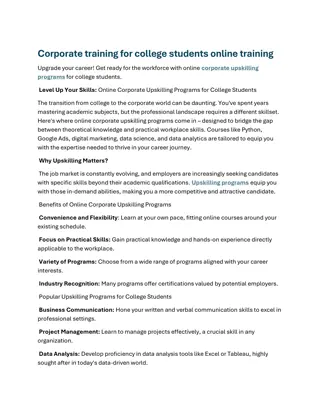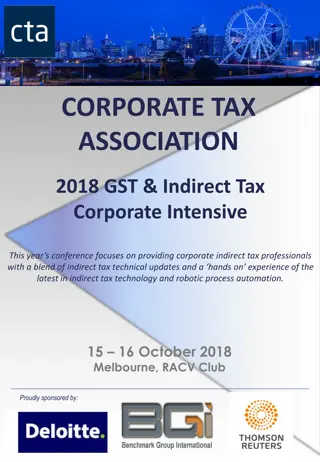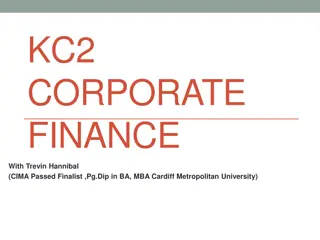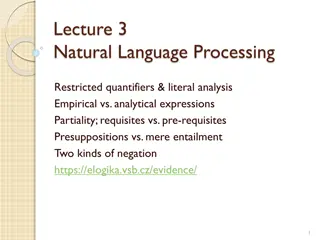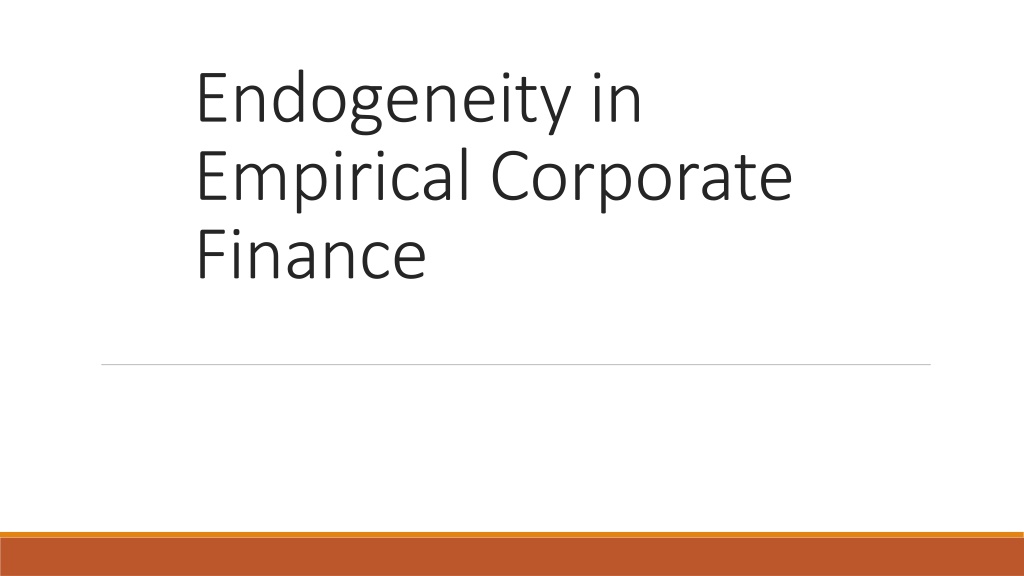
Understanding Endogeneity in Corporate Finance
Endogeneity, a common issue in corporate governance and finance, refers to the correlation between explanatory variables and errors in regression models. This leads to biased parameter estimates, hindering reliable inference. Omitted variables, simultaneity, and measurement errors are sources of endogeneity. Addressing this problem is crucial for accurate analysis.
Download Presentation

Please find below an Image/Link to download the presentation.
The content on the website is provided AS IS for your information and personal use only. It may not be sold, licensed, or shared on other websites without obtaining consent from the author. If you encounter any issues during the download, it is possible that the publisher has removed the file from their server.
You are allowed to download the files provided on this website for personal or commercial use, subject to the condition that they are used lawfully. All files are the property of their respective owners.
The content on the website is provided AS IS for your information and personal use only. It may not be sold, licensed, or shared on other websites without obtaining consent from the author.
E N D
Presentation Transcript
Endogeneity in Empirical Corporate Finance
Endogeneity in Empirical Corporate Finance Endogenous problem is an important issue in the fields of corporate governance and corporate finance. Roberts, Michael R. and Whited, Toni M., Endogeneity in Empirical Corporate Finance (October 5, 2012). Simon School Working Paper No. FR 11-29. 2
Introduction to Endogeneity What is endogeneity ? Loosely define as a correlation between the explanatory variables and the error in a regression. Problem of endogeneity Leads to biased and inconsistent parameter estimate that make reliable inference virtually impossible 3
Introduction to Endogeneity The first step to address endogeneity Which variables are endogenous Why they are endogenous Sources of endogeneity Omitted variables Simultaneity Measurement error Ways to address endogeneity problem 4
Omitted Variables Omitted variables: variables that should be included in the (vector of) explanatory variables, but for various reasons are not. For example, executive compensation may depend on executives ability, which are difficult to quantify and observe. 5
Omitted Variables Assume the true economic relation is ? = ?0+ ?1?1+ ?2?2+ + ????+ ?? + ? ? is an unobservable explanatory variables and ? is its coefficient. The estimable regression is ? = ?0+ ?1?1+ ?2?2+ + ????+ ? ? = ?? + ? is the composite error term. 6
Omitted Variables If the omitted variable ? is correlated with any of the explanatory variables (?1, ,??), the composite error term v is correlated with the explanatory variables. Thus all elements of ? are inconsistent estimates. plim ??= ??+ ????(??,?) ,? = 1, ,? ???(??) Corporate finance assume that all of the other explanatory variables are partially uncorrelated with the omitted variable 7
Omitted Variables Economic meanings of estimator plim ??= ??+ ????(??,?) ,? = 1, ,? ???(??) If ? and ?? are uncorrelated (???(??,?) = 0), then OLS estimator is consistent. If ? and ?? are correlated (???(??,?) > 0), then OLS estimator is inconsistent. ???(??,?) ???(??)have the same (different) sign, the bias is positive (negative). If ? and 8
Omitted Variables: An Example Firm size is a determinant in CEO compensation (Core, Guay, and Larcker, 2008) Large firms are more difficult to manage and then require more skilled manager (Gabaix and Landier, 2008). Firm size is endogenous because managerial ability, which is unobservable (is in the error term) and is correlated with firm size. 9
Simultaneity Simultaneity bias occurs when y and one or more of the x s are determined in equilibrium xk y or y xk For example, when examining the relation between antitakeover provision and firm value Antitakeover provisions leads to a loss in firm value Managers of low-value firm adopt antitakeover provisions in order to entrench themselves 10
Simultaneity Assume y and x are determined jointly as follow: ? = ?? + ? ? = ?? + ? where u is uncorrelated with v. Thus ? =???(?,?) ???(?)=???(?,??+? ) where ???(?,?) ???(?)= = ? +???(?,?) ???(?) ???(?) ? 1 ?? ???(?) ?2??? ? +???(?) 11
Measurement Error Most empirical studies in corporate finance use proxies for unobservable or difficult to quantify variables. Any difference between the true variable of interest and the proxy leads to measurement error. Record variables incorrectly Conceptual differences between proxies and their unobservable counterparts Measurement error leads to regression error 12
Measurement Error Measurement error in the dependent variable Consider a main variable of interest in capital structure theories should be market leverage ratio (Fischer, Heinkel, and Zechner, 1989) Ratio of the market value of debt to the market value of firm (debt plus equity) Market value of debt is difficult to measure because most debt is privately held by banks and other financial institutions; and most of public debt is infrequently traded. 13
Measurement Error Often use book debt value as a proxy; creates a wedge between the empirical measure and the true economic measure. Total compensation (including stock options) for executives can also be difficult to measure Stock options often vest over time and are valued by an approximation, e.g. Black-Scholes (Core, Guay, and Larcker, 2008) 14
Measurement Error Consider the following model ? = ?0+ ?1?1+ ?2?2+ + ????+ ? where y*is an unobservable measure and y is the observable version of or proxy for y*. The difference between the two is w = y y*. The estimable model is ? = ?0+ ?1?1+ ?2?2+ + ????+? where v = w + u is the composite error OLS estimates might be inconsistent, which are similar to those of an omitted variable 15
Measurement Error Measurement error in the independent variables Assume the estimation model is ? = ?0+ ?1?1+ ?2?2+ + ???? +? is an unobservable measure and ?? is it observable proxy. Define measure error to . The estimable model is ? = ?0+ ?1?1+ ?2?2+ + ????+ v where ?? be w = ?? ?? where ? = ? ???? is the composite error term. 16
Measurement Error Since ? is uncorrelated with each ??, OLS will produce consistent estimates. When the measurement error appears in the independent variables, it will affect the variance of the error term, which changes from ??? ? = ?? ?? 2 to ??? ? ??? = ?? 2+ 2?? 2 2?????. 17
Ways to Address Endogeneity Problem Rely on a clear source of exogeneous variation for identifying the co-effects of interest Instrumental variables Difference-in-difference estimator Regression discontinuity design* Rely more heavily on modeling assumption Panel data methods, e.g., fixed and random effects Matching methods Measurement error methods. 18
Instrumental Variables Basic econometric framework Recall the single equation linear model ? = ?0+ ?1?1+ ?2?2+ + ????+ u Suppose one regressor, ?? is correlated with ?, then only the estimate of ??is biased. An instrument, z, is a variable that satisfies two conditions that we refer to as the relevance and exclusion conditions 19
Instrumental Variables Relevance condition Requires that the partial correlation between the instrument and the endogenous variable not be zero; It requires the coefficient ? in the regression does not equal zero. Exclusion condition ??? ?,? = 0, it implies that the only role that the instrument z plays in influencing the outcome y is through its affect on the endogenous variable ?? ??= ?0+ ?1?1+ + ?? 1?? 1+ ? + ? 20
Instrumental Variables There is noting restricting the number of instruments to just one From an asymptotic efficiency perspective, more instruments is better. From a finite sample perspective, more instruments is not necessarily better and can even exacerbate the bias inherent in 2SLS There is noting restricting the number of endogenous variable to just one. 21
Instrumental Variables Two-stage least squares (2SLS) Estimate the predicted variable, ??, by regressing the endogenous variable ?? on all of the exogenous variables Controls ?1, ,?? 1 and instruments ?1, ,?? Replace the endogenous variable ?? with its predicted values from the first stage ??, and regress the outcome variable y on all of the control variables and ??. 22
Instrumental Variables This two-step procedure can be done all at once; but not separately estimate the first and second stages. Generate regressor, ?? in the second stage itself will induce estimation error. This estimation error must be taken into account when computing the standard error of its, and the other explanatory variables coefficients. 23
Instrumental Variables Where do valid instruments come from? The only way to find a good instruments is to understand the economic of the question. Institutional changes (or policy changes) 24
Instrumental Variables Bennedsen et al. (2007): study CEO succession in family firms; whether replacing an outgoing CEO with a family member hurts firm performance? Dependent variable: firm performance Explanatory variable: family CEO succession Sources of endogeneity The characteristics of the firm and family that cause it to choose a family CEO may also cause the change in performance (omitted variable) 25
Instrumental Variables Bennedsen et al. (2007) choose an IV approach to isolate exogenous variation in the CEO succession decisions. The instrument, z, Bennedsen et al. (2007) choose is the gender of the first- born child of a departing CEO. Do not affect firm performance Might be correlated with family CEO succession 26
Instrumental Variables Results of Bennedsen et al. (2007) CEO with boy-first families are significantly more likely to appoint a family CEO in the first stage regression (relevance condition is satisfied) In the second stage regression, the IV estimates of the negative effect of in-family CEO succession are much larger than the OLS estimates. 27
Lagged Instruments The use of lagged dependent variables and lagged endogenous variables has become widespread in corporate finance. Use lagged values of the dependent variable 28
Difference-in-Differences Difference-in-Differences (DD) estimators are used to recover the treatment effects stemming from sharp changes in the economic environment, government policy, or institutional environment. Single cross-sectional differences after treatment Single time-series differences after treatment Double difference estimator: Difference in Differences 29
Difference-in-Differences Single cross-sectional differences after treatment Compare the post-treatment outcomes of the treatment and control groups. Example: Estimate the effect of state antitakeover laws on leverage by examine one year of data after the law passage (Garvey and Hanka, 1999). 30
Difference-in-Differences Compare the leverage ratios of firms in states that passed the law (treatment group) and did not pass the law (control group): ? = ?0+ ?1? + ? where y is leverage, and d is the treatment assignment indicator equal to one if the firm is incorporated in a state that passed the antitakeover law and zero otherwise. The difference between treatment and control group averages is ?1 31
Difference-in-Differences Single time-series differences before and after treatment Compare the outcome after the onset of the treatment with the outcome before the onset of treatment for just those subjects that are treaded. Example Examine the impact of deregulation of the French banking industry on the behavior of the borrowers and banks (Bertrand, Scholar, and Thesmar, 2007). 32
Difference-in-Differences One before and one after treatment: comparison can be accomplished with a two period panel regression using only subject affected by the event ? = ?0+ ?1? + ? where p equals one if the observation is made after treatment onset (i.e. post-treatment) and zero otherwise (i.e. pre-treatment) The treatment effect is ?1. 33
Difference-in-Differences Double difference estimator: difference-in differences (DD) Combine cross-sectional/time-series estimators to take advantage of both estimators strengths Consider firm-year panel dataset in which there are two time periods, one before and one after the onset of treatment, and only some of the subjects are treated. 34
Difference-in-Differences For example, Arizona passed antitakeover legislation in 1987 at which time Connecticut had not passed (Bertrand and Mullainathan, 2003). 1986: pre-treatment period 1987: post-treatment period Firms registered in Arizona: treatment group Firms registered in Connecticut: control group 35
Difference-in-Differences ? = ?0+ ?1? ? + ?2? + ?3? + ? where d is the treatment assignment variable equal to one if a firm is registered in Arizona, zero if registered in Connecticut; p is the post-treatment indicator equal to one in 1987 and zero in 1986. ?1 represents the DD estimate. ? ? ? = 1,? = 1 = ?0+ ?1+ ?2+ ?3 ? ? ? = 1,? = 0 = ?0+ ?2 ? ? ? = 0,? = 1 = ?0+ ?3 ? ? ? = 0,? = 0 = ?0 36
Difference-in-Differences 1987 1986 AZ: CT: ?1+ ?3: Difference between 1987 and 1986 in AZ ?3: Difference between 1987 and 1986 in CT ?1+ ?2: Difference between AZ and CT in 1987 ?2: Difference between AZ and CT in 1986 ??: Difference-in-Differences (double difference estimator) 37
Panel Data Methods Assume a panel regression model as follow: ? = ?0+ ?1???+ ??? The error term, ??? can be decomposed as ???= ??+ ???. ??can be interpreted as capturing the aggregate effect of all of the unobservable, time-invariant explanatory variables for ??? If ??and ???are correlated, then ??is referred to as a fixed effect. If ??and ???are NOT correlated, then ??is referred to as a random effect. 38
Panel Data Methods In the former case (??and ???are correlated), endogeneity is obviously a concern In the later, endogeneity is not a concern; however, the computation of standard error is affected. Fixed effects Industry fixed effect Year fixed effect Firm fixed effect Petersen s clustering-adjusted standard error 39
Ownership Structure around the World LLS (1999): better (poor) investors protection is associated with dispersed (concentrated) ownership structure The classification of countries based on the legal rules for protecting minority shareholder may be endogenous. Countries with economically and politically powerful controlling shareholders may enact laws that entrench such shareholders and reduce minority rights. 40
Ownership Structure around the World Way to solve endogenous Use the origin of the commercial laws instead of the legal rules of investor protecting. Common law ( ) vs Civil law ( ) Both historically predetermined and highly correlated with shareholder protection Historically predetermined means that both cannot be changed in the current (X Y but not Y X). Common law is associated with good legal protection on minor shareholders, while Civil law is not. 41
The Fraction of Widely Held Firms around the World Common law Civil law Diff (t-statistic) Countries with Common (Civil) law have higher (lower) fraction of widely held firms Results are robustness across different criteria of control (20%, 10%) and different sample selection (large, medium) 42
Family Ownership & Firm Value An alternative explanation for the performance difference is that families in poorly performing firms (or foreseeing poor performance) are more likely to sell their shares and exit the firm. Use instrumental variable (IV) regressions (two-stage least squares) to examine the nature of causality between family ownership and firm performance. Results still hold. 43
Endogeneity Concern Two-stage Least Squares The first-stage: regress family ownership on the natural log of total assets, the square of the natural log of total assets, and monthly stock return volatility. The predicted value of family firms is defined as instruments. The second-stage: regress performance measures on the predicted value of family firms, and other control variables. 44







